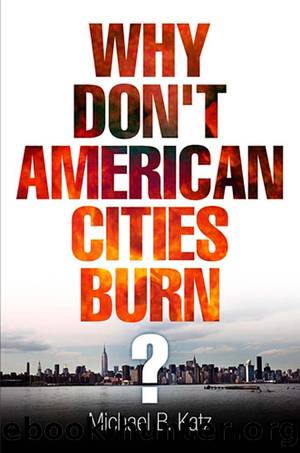Why Don't American Cities Burn? by Michael B. Katz

Author:Michael B. Katz
Language: eng
Format: epub
Publisher: University of Pennsylvania Press
Published: 2012-11-14T16:00:00+00:00
Prospecting for Wealth in Inner Cities
Consider, first, markets, or their absence. The zones of concentrated poverty at the heart of older American cities lay outside legitimate marketsâdrug markets and an informal economy substituted for the institutions of commerce and manufacturing that had fled. Prices had dropped so low, supply so outstripped demand, that no housing market existed. Supermarkets and banks exited, leaving residents dependent on small, low-quality, overpriced local grocers and exploitive check-cashing services. Industries had decamped to suburbs, Latin America, or Asia. With public assistance, food stamps, SSI, and a few other transfer programs, governments kept poor people alive, but not much more. Most of the community development and empowerment programs optimistically launched in the heady days of the War on Poverty and Great Society had folded.
What remained was the institutional cluster that the great urban photographer Camilo José Vergara labels the institutional ghettoâthe prisons, halfway houses, clinics, and homeless shelters that constitute the institutions of punishment, social control, and welfare.38 Faced with this situation, it was reasonable for urban planners to think that the way to jump start inner-city revitalization and to attack poverty lay in the re- creation of markets. The first plan, launched during Ronald Reaganâs presidency, was Enterprise Zones, which proved a disappointment. The Clinton administration revived the idea with a new twist and a new name, Empowerment Zones. They also fell short of expectations.
Enterprise zones were a British import, first advocated in 1977 by British urban planner Peter Hall and implemented by Margaret Thatcherâs chancellor of the Exchequer, Geoffrey Howe. Their American champion, Congressman Jack Kemp, failed to persuade Congress to pass a comprehensive Enterprise Zone bill, but a number of states acted on their own, designating zones in which they offered firms a miscellaneous assortment of incentives. The idea, pointed out urbanists Philip Kasinitz and Jan Rosenberg, sounded âlike simple common sense: use tax breaks and other incentives to encourage private employers to locate in poor areas, bringing job opportunities to local residents.â The appeal of Enterprise Zones extended across the political spectrum. âConservatives like them because they promise reduced government and a private-sector answer to poverty. Liberals are attracted by the promise of âempowermentâ for the local community. And enterprise zones have a strong non-ideological selling point: they are cheap.â After all, they were paid for largely by âuncollected taxes on as yet unmade profits.â Alas, the incentives proved too weak to attract many businesses, and many of the firms that relocated to them failed to employ local workers.39
The Clinton administration tried to improve on the Enterprise Zone idea with the Empowerment Act of 1993, which called for nine âempowerment zonesâ and ninety-five âenterprise communitiesâ in both rural and urban areas. Both would be eligible for a bundle of tax breaks and other incentives, such as accelerated depreciation for investments in the zone, tax credits for employment and training, and small inducements to hire local residents. Unlike the earlier plans, Clintonâs added eligibility for social services and community-based programs in education, housing, and crime prevention.
Download
This site does not store any files on its server. We only index and link to content provided by other sites. Please contact the content providers to delete copyright contents if any and email us, we'll remove relevant links or contents immediately.
Zero to IPO: Over $1 Trillion of Actionable Advice from the World's Most Successful Entrepreneurs by Frederic Kerrest(4304)
Machine Learning at Scale with H2O by Gregory Keys | David Whiting(4194)
Never by Ken Follett(3799)
Harry Potter and the Goblet Of Fire by J.K. Rowling(3776)
Ogilvy on Advertising by David Ogilvy(3517)
Shadow of Night by Deborah Harkness(3307)
The Man Who Died Twice by Richard Osman(2998)
Book of Life by Deborah Harkness(2869)
The Tipping Point by Malcolm Gladwell(2829)
Will by Will Smith(2795)
0041152001443424520 .pdf by Unknown(2785)
My Brilliant Friend by Elena Ferrante(2776)
How Proust Can Change Your Life by Alain De Botton(2746)
Purple Hibiscus by Chimamanda Ngozi Adichie(2653)
How to Pay Zero Taxes, 2018 by Jeff A. Schnepper(2602)
Hooked: A Dark, Contemporary Romance (Never After Series) by Emily McIntire(2502)
Rationality by Steven Pinker(2291)
Borders by unknow(2232)
Can't Hurt Me: Master Your Mind and Defy the Odds - Clean Edition by David Goggins(2230)
